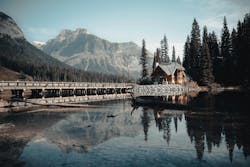Codes in Florida Panhandle Made Buildings Vulnerable to Hurricane Michael
Florida lawmakers and code policy officials have questioned the state’s approach to building codes in the wake of Hurricane Michael. The Category 4 storm, with sustained winds of 155 mph, decimated coastal areas of the Florida Panhandle. Statewide codes have hurricane-resilient provisions, but they vary by region.
New office buildings and homes in Miami-Dade County must be designed to withstand winds around 175 mph. Along the stretch of the Panhandle hit hardest by Michael, though, the design standard varies from 120 mph to 150 mph.
In hard-hit Mexico Beach, some homes constructed under the latest code instituted in 2002 were destroyed. Code requirements have been based on storm history and the likelihood of future hurricanes striking a particular area. The Panhandle had seen few big storms since the 1800s, and Michael is the first known Category 4 hurricane to strike the region. Lawmakers and code officials now say codes may have to be strengthened in the northern part of the state.
Low-Income Neighborhoods Could Benefit Most from Green Roofs
Heat waves are the nation’s deadliest weather hazard, accounting for one-fifth of all deaths caused by natural hazards in the U.S. Low-income people in urban areas tend to be most vulnerable to extreme heat. These neighborhoods often have a lot of hardscape that absorbs solar radiation during the day, without many parks or trees to mitigate this effect. Some of the poorest residents do not have air conditioning. Businesses in vulnerable neighborhoods use more energy than enterprises in more affluent areas because of higher temperatures.
So, green roofs that help cool buildings and green infrastructure could be most impactful in low-income areas of cities. Other options such as vertical gardens on a building’s exterior and white rooftops can help moderate urban temperatures, cut utility bills, and improve quality of life.
Researchers from the University of Notre Dame team identified Chicago neighborhoods that had the most to gain from green roofs by figuring out which ones had the most heat vulnerability, the greatest potential reductions in rooftop temperatures, and used the most electricity for cooling. Researchers also designed steps for urban planners to set priorities for a public effort to install green roofs.
Experimental Alabama Community Can Run its Own Microgrid
Reynolds Landing, a 62-house subdivision in a suburb of Birmingham, Alabama, features numerous energy efficiency features and the ability to run its own microgrid. The “smart neighborhood” is connected to its own microgrid, composed of a mix of solar panels, battery storage, and a gas-powered generator.
The houses contain internet-of-things (IoT) technology that will give homeowners unusual control over how their houses operate. It will also allow Alabama Power to control electricity going to water heaters and heating and cooling equipment. The utility is a sponsor of the project, and it aims to understand how homeowners will use electricity in the years ahead as prices for renewable energy fall, codes tighten, and high-performance houses become more popular.
To Create More Middle Market Housing, Developers Should Change Discussion with Zoning, Planning Officials
Increasing housing in the middle market requires that developers change how they discuss multifamily projects with zoning and planning officials, and with residents of single-family areas where more housing is needed, according to a California designer. According to a report at GlobeSt, Daniel Parolek of Berkeley, Calif.-based Opticos Design, says the “missing middle” includes duplexes, fourplexes, cottage courts, and mansion apartments.
These projects are house-scale, but with multiple units inside of them. Gaining community support for a broad increase in missing middle housing requires developers and architects to discuss these projects with government officials and others more effectively. This includes changing the conversation to focus on the form and scale of the buildings rather than the density.
Threat of Wildfires Not Deterring Home Market in the West
Despite the risk of wildfires, the market for homes in and around forested areas of the western U.S. remains robust. Wildfires drive down real estate prices only in the immediate aftermath of a disaster, according to a study by researchers at the University of Nevada, Las Vegas.
Home prices typically rebound to pre-fire levels within one to two years, the researchers say. The threat of wildfires increases as the population grows because people often unintentionally spark fires. Despite widespread, damaging wildfires in recent years, residential growth in forested areas across the U.S. has jumped from an estimated 12.5 million housing units in 2000 to 44 million in 2010.
